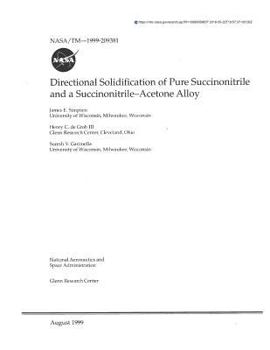Directional Solidification of Pure Succinonitrile and a Succinonitrile-Acetone Alloy
An experimental study of the horizontal Bridgman growth of pure succinonitrile (SCN) and of a succinonitrile-1.0 mol.% acetone alloy (SCN-1.0 mol.% ACE) has been performed. Experiments involving both a stationary thermal field (no-growth case) and a translating thermal field (growth case) were conducted. Growth rates of 2 and 40 micrometers/s were investigated. For the pure SCN experiments, the velocity field in the melt was estimated using video images of seed particles in the melt. Observations of the seed particles indicate that a primary longitudinal convective cell is formed. The maximum velocity of two different particles which traveled along similar paths was the same and equal to 1.49 +/- 0.01 mm/s. The general accuracy of velocity measurements is estimated to be +/- 0.08 mm/s, though the data shows consistency to within +/- 0.02 mm/s. The shape of the solid/liquid interface was also quantitatively determined. The solid/liquid interface was stable (non-dendritic and non-cellular) but not flat; rather it was significantly distorted by the influence of convection in (he melt and, for the growth case, by the moving temperature boundary conditions along the ampoule. It was found that the interface shape and position were highly dependent on the alignment of the ampoule in the apparatus. Consequently, the ampoule was carefully aligned for all experiments. The values for front location agree with those determined in previous experiments. For the alloy experiments, the solid/liquid interface was determined to be unstable at growth rates greater than 2.8 micrometers/s, but stable for the cases of no-growth and growth at 2 micrometers/s. When compared to the shape of the pure SCN interface, the alloy interface forms closer to the cold zone, indicating that the melting temperature decreased due to the alloying element. Extensive temperature measurements were performed on the outside of the ampoule containing pure SCN. The resulting thermal profiles are presented in de
Format:Paperback
Language:English
ISBN:1723828351
ISBN13:9781723828355
Release Date:January 1
Publisher:Independently Published
Length:70 Pages
Weight:0.41 lbs.
Dimensions:0.1" x 8.5" x 11.0"
Customer Reviews
0 rating





